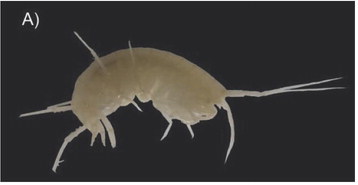Verification of unique species could come with naming rights
BY SHEILA HARRIS sheilaharrisads@gmail.com
Based on genetic testing, there’s a “high probability” that Roaring River Spring Cave is home to a unique species of amphipod.
Dr. Fernando Calderon Gutierrez, a marine research scientist with Texas A&M in San Antonio and a member of the KISS Rebreathers dive team, collected the amphipod and two species of isopods during the KISS team’s exploratory dive into the cave in September 2022.
Since then, he has been analyzing and reconstructing the amphipod’s DNA sequence and comparing it to the DNA sequences of over 9,900 other species of amphipods which have been identified and named, and for which DNA information is available.
Amphipods, crustaceans which look like tiny shrimp, are common in all marine environments, including freshwater and salt water.
“So far, the DNA from the Roaring River specimen does not match the DNA of any of the other known species,” Gutierrez said.
According to Gutierrez, scientists sometimes only have fragments of the DNA information for other species, which makes comparison difficult.
“At this point, I’ve been able to reconstruct the mitochondrial genome of the Roaring River amphipod — a sequence of 16,296 letters of DNA,” Gutierrez said.
“[So far], we can confirm that the amphipod is from the genus Stygobromus, and that the DNA from the sample in Roaring River does not correspond to other species with DNA sequences available,” he said.
Gutierrez said even though it appears that Roaring River’s amphipod is a unique species, he has more comparison work to do, meaning the results of his study are still preliminary.
If the amphipod is indeed unique, it will be subject to naming using binomial nomenclature.




